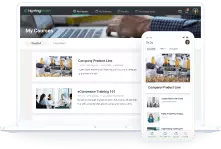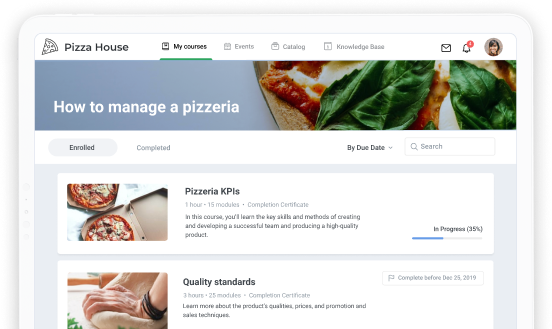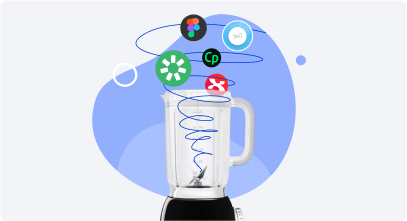How to Migrate to a New LMS and Why You May Need It

Swapping an LMS seems to be a complicated project. In fact, it is quite similar to moving to a new house. If you do your homework, carefully pack your belongings, and deliver them to the new place, moving is a lot easier.
In this article, we’ll look at the cases where it’s better to change your current LMS, what not to miss when choosing a new platform, how to make a migration plan, and how to migrate to a new platform without trauma.
4 Reasons to Change Your LMS
#1 You don’t have a single platform for all types of learning
You may use multiple eLearning authoring tools to develop training: a knowledge base, corporate intranet, social media, a service for taking quizzes, a service for conducting webinars, and so on. Sooner or later, you’ll have to face the challenge of unifying the quality of learning content, and making training analytics transparent. In this case, an LMS helps to gather all the training activities in one place and create a single learning command center.
#2 Your LMS is out of date
If you use custom software, it can become outdated very quickly. It may lead to problems with support of new eLearning content formats, inability to use mLearning, and non-relevant metrics collection and reporting. There are two options: you can either hire a full-time developer who will further customize your outdated platform, or switch to a new third-party LMS. Carefully consider all the key LMS benefits and drawbacks and make your choice.
#3 Your LMS is too complicated or expensive
Perhaps you’ve conducted an intro class, but users are still stumbling all the time and overwhelming administrators with questions. You can assign someone to support the users, create instructions and video tutorials on how to use your own LMS, or move to a more user-friendly platform.
To make a decision, calculate how much you spend on the maintenance of your current LMS. You’ll be able to cut some expenses such as tech support if you switch to an LMS provider who takes care of this kind of issue.
#4 Your company is growing faster than your LMS
Let’s say you’d like to implement a new employee incentive program, integrate the training results with your corporate BI (Business Intelligence) system, or significantly increase the number of learners, but your current platform doesn’t have capability. In this case, contact your provider and discuss their plans for developing the platform. Maybe you’ll be able to order a custom modification or integration with a third-party service for a specific project, and that will be enough to solve your problem. If any of these requirements constrain your current system it may be time to look in the direction of another platform.
Choosing a New LMS
The decision is made; your organization has outgrown its LMS or is allocating too many resources on maintenance. You’re swapping out platforms. The next step is to find a new LMS.
First, define all the business and training needs that you want to cover after migration. To do this, create a user group from different departments and discuss what teachers and employees like about your current system and what they don’t. Write down all the requirements and then begin to select the appropriate solution. Here is a list of questions that experts advise you to ask a vendor before purchasing an LMS.
Pro Tip: Don’t hesitate to ask vendors about discounts when migrating from another LMS and whether the vendor will assist you with the migration. For instance, if you switch from any LMS to iSpring Learn, there is a 20% discount for the first year of use.
Once you’ve made up a short list, you can plan a soft launch.
Drawing up an LMS Migration Plan
Step 1: Backup
Make backup copies of all the data you can from your current LMS. Backups can save your nerves (and maybe your job) if something goes wrong.
Step 2: Revision
Just like revising your wardrobe when moving, there’s no need to take everything with you to a new closet. Think what you can “throw away”, or at least archive. To do this, make lists of all materials and data:
- Users: Profiles and roles of employees, trainers, and administrators.
- Content: Training programs, files, courses, and external libraries. Note that different systems often support different types of content, and you may have to adapt your materials or convert to other formats.
- Statistics: Users’ results on courses and tests, history of activities, achievements, and certificates. Determine which data can be simply exported as Excel or CSV files, and which data must be transferred to a new LMS.
Step 3: Migration pipeline
When you define what content you need to transfer, work out a pipeline: write down the migration plan, and determine deadlines and budget. The easiest way is to launch a pilot project in one of the departments and test drive the new platform.
Launching a Pilot Project
Instead of transferring all the content at once and disabling access to the previous platform, test the new LMS on a small group of users. For example, you can transfer only the content for the sales department, conduct intro training, and invite employees to take a couple of courses. This way, you can get the initial results in just a day or two.
A soft launch helps you get objective feedback, find and eliminate all errors at an early stage, and make a final choice. Find out if it’s comfortable for users, trainers, and administrators to use the new platform and check with your initial learning objectives.
In just a month, a pilot project lets you test all the training scenarios and see if you need to fine-tune any system settings or training programs before going live. After getting good results during the soft launch, you can migrate step by step to the new system: transfer materials according to your plan, conduct intro training, and invite the rest of the employees.








